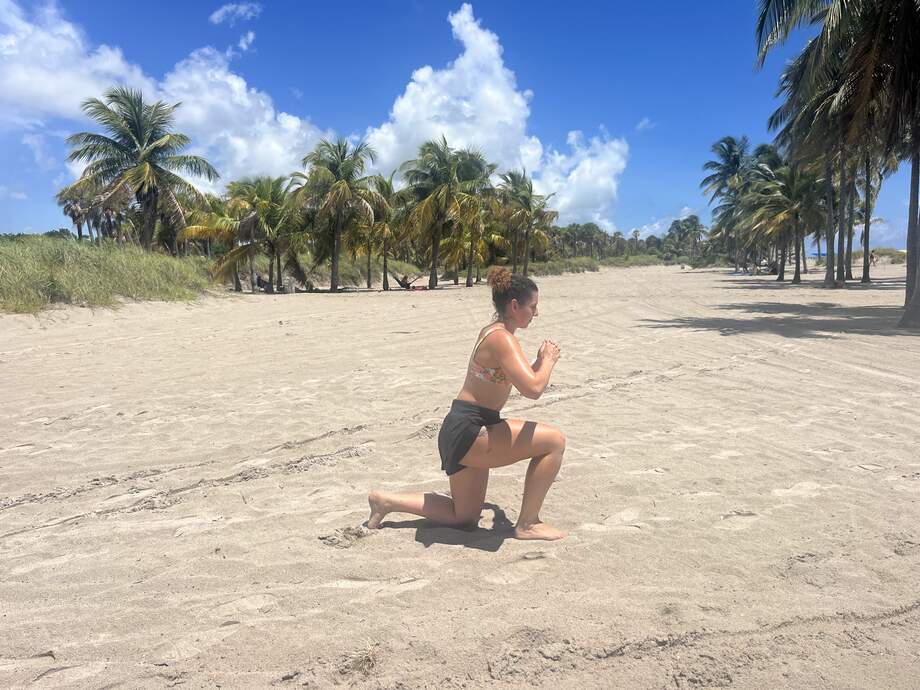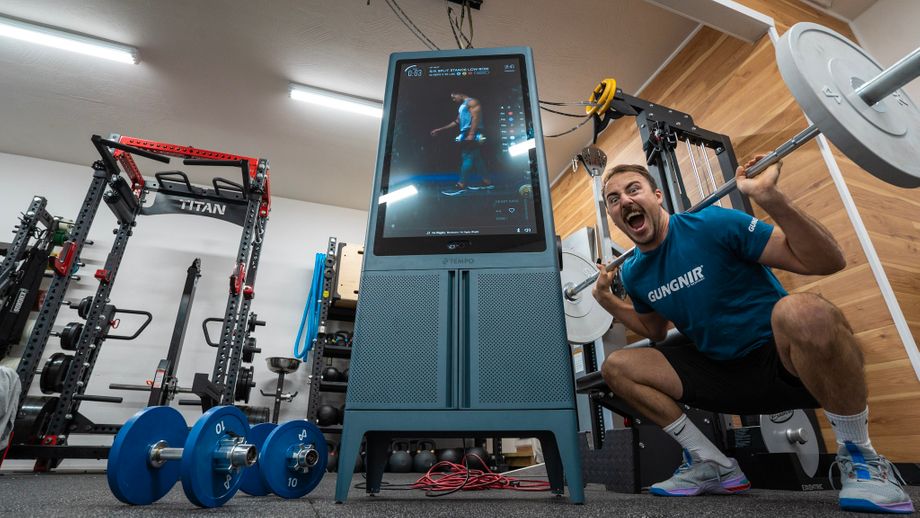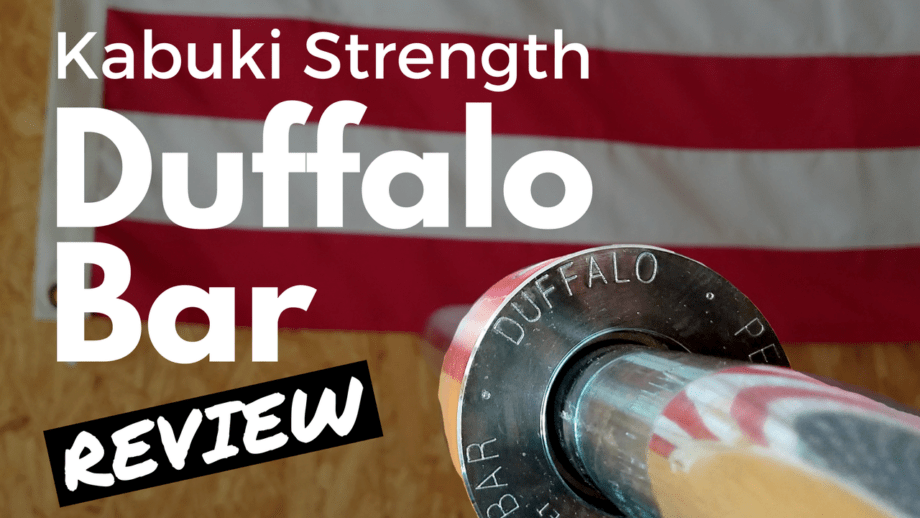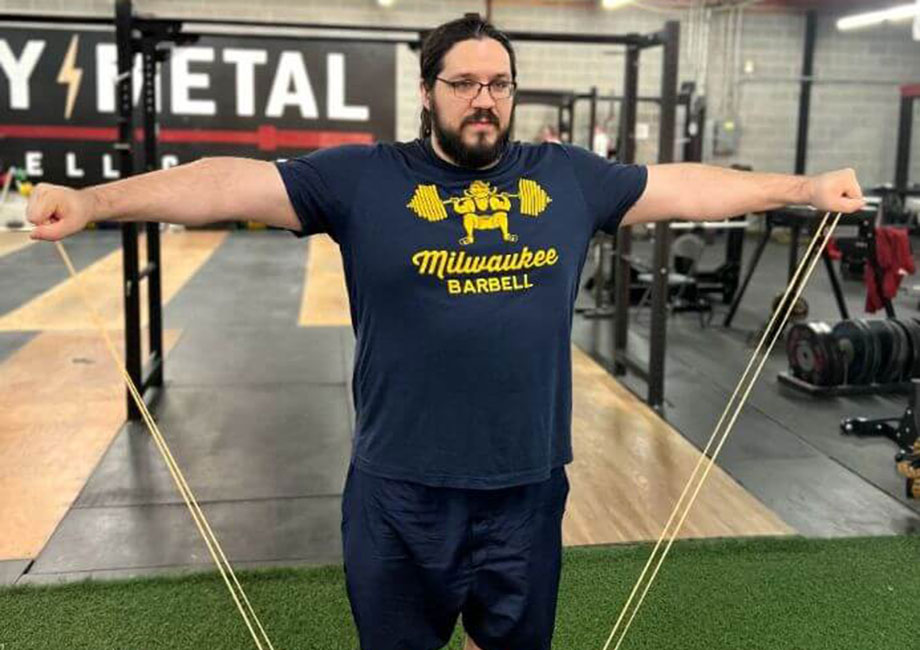Headed out on vacation? No matter if you’re headed to sunny Southern California, the Maldives, or Bimini Island, most of us fitness fiends all have one thing in common: We’re still going to get our workouts in on vacation!
While I encourage you to take a well-deserved break if needed, I know that I get antsy and anxious if I go too long without a good sweat session. If you find yourself in the same boat, you’ll be glad you stumbled upon this beach workout guide. This is a true no-equipment workout—you don’t even need a dumbbell, as it includes only bodyweight exercises. (Light packers, rejoice.)
Plus, you don’t need to work out for very long on the sand to get the beneficial effects. Research published in the Journal of Experimental Biology1 found that running in the sand requires 1.6 times more energy than running on a hard surface because of the way that sand absorbs motions.
I tapped into my seven years of experience as a certified personal trainer and functional training specialist to bring you this step-by-step guide that will make your muscles and lungs burn. Enjoy, and don’t forget your sunscreen!
RELATED: Benefits of Running on the Beach
Move 1: Air Squats
Why we love it: Simplistic in nature and the foundation of functional fitness, air squats are beginner-friendly but suitable for anyone at any fitness level.
How to do it:
- Start standing with your feet shoulder-width apart or hip-width apart: whichever is more comfortable for you.
- Keeping your gaze forward and chest up, lower your body into the squat position. Descend as low as you can without your heels raising up from the ground or your chest folding forward.
- Ascend to standing, fully extending your hips before beginning another rep.
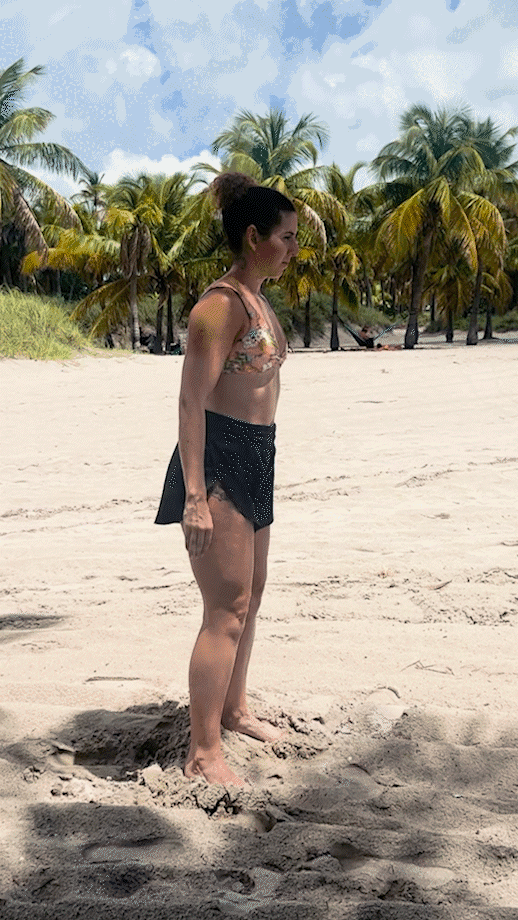
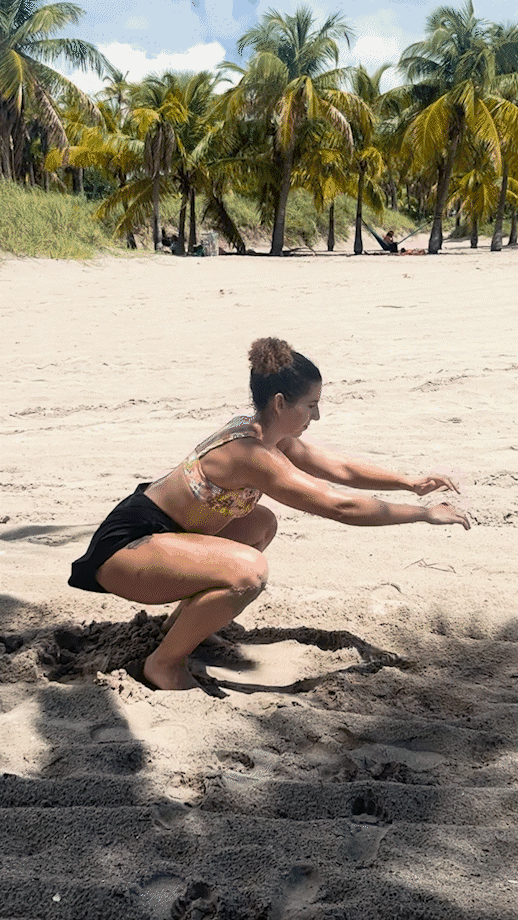
Up the Challenge: Squat Jumps
Looking for a deeper burn? Turn those air squats into jump squats for the explosive benefits of plyometric exercises.
How to do it:
- Start in the same position as you would with air squats: feet hip-width or shoulder-width apart.
- Lower your body into the squat position, again going as deep as you can without compromising your form.
- Drive your heels into the ground and engage your hamstrings and glutes to propel your body upward. Try to get both feet at least a couple of inches off the ground. It will be tough in the sand, which absorbs motion!
RELATED: What Muscles Do Squats Work?
Move 2: Reverse Alternating Lunges
Why we love it: A fantastic lower-body exercise, reverse alternating lunges require core stabilization and balance. In the sand, these elements become even more challenging.
How to do it:
- Start standing tall with your hands by your sides or clasped in front of your chest.
- Step your left foot back and slowly lower your left knee to the sand.
- Driving through the heel of your right foot and engaging the muscles in your right leg, return to standing.
- Step your right foot back and slowly lower your right knee to the sand.
- Drive through the heel of the left foot and engage the left leg to return to standing.
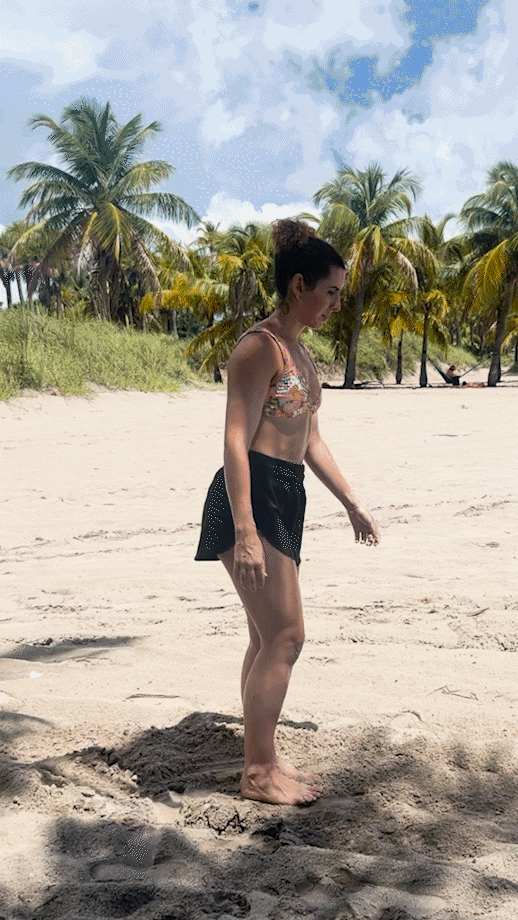
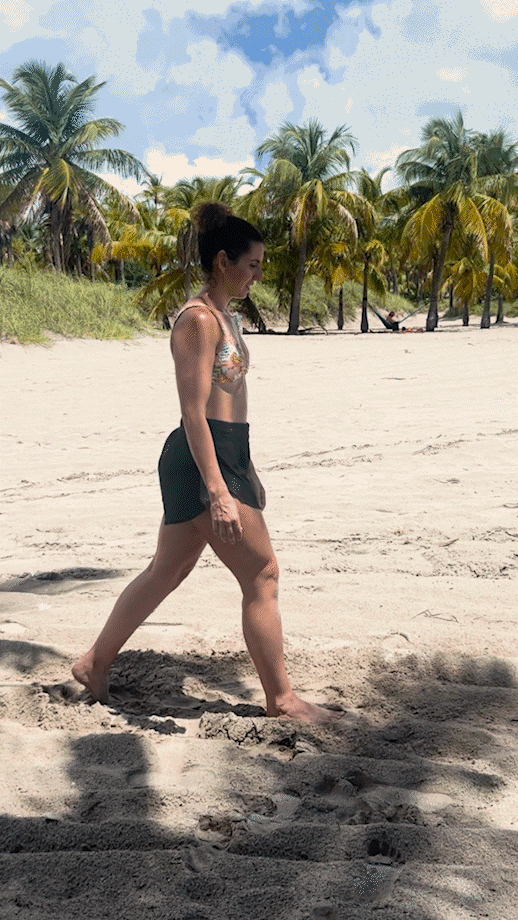
Up the Challenge: Jumping Lunges
This high-intensity version of the alternating lunges exercise will get your heart rate soaring as if you’re doing sprints, and it works your entire body.
How to do it:
- Start in the same way you’d start the reverse alternating lunges.
- Step your left foot back and slowly lower your left knee to the sand.
- Explosively drive both feet into the ground, propelling your body into the air.
- While in the air, switch the positioning of your feet.
- Land with your left foot in front and right knee on the sand.
- Repeat, switching your feet in the air during each jump.
Move 3: RDL to High Knee
Why we love it: This compound movement works your hamstrings, glutes, and hip flexors all at once. In the sand, it will seriously challenge your balance and coordination.
How to do it:
- Start standing with your feet hip-width apart.
- Lift your right foot up from the ground.
- Drive the hips back into a hip hinge and lean forward, reaching your fingers toward the ground. Touch the sand in front of your planted foot if you can.
- Squeeze the glutes and hamstrings to pull your torso back to its neutral position. Make sure to extend your hips fully before beginning another rep.
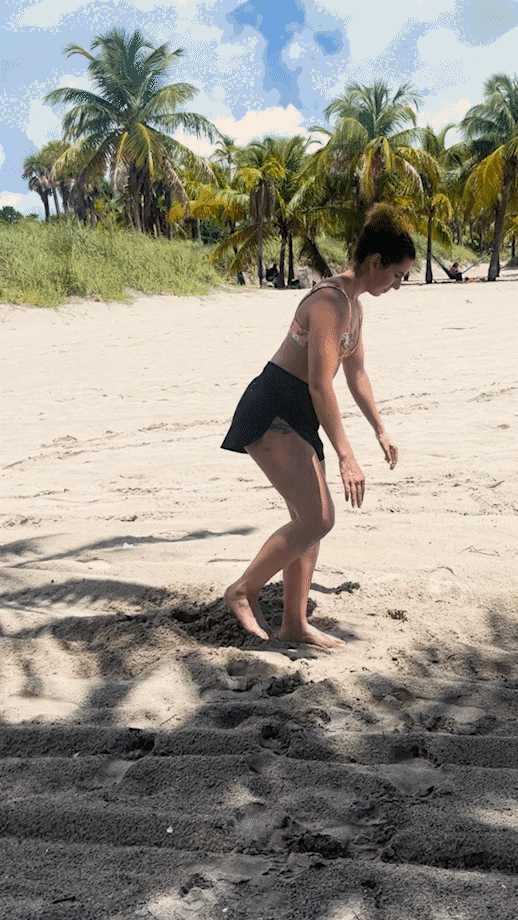
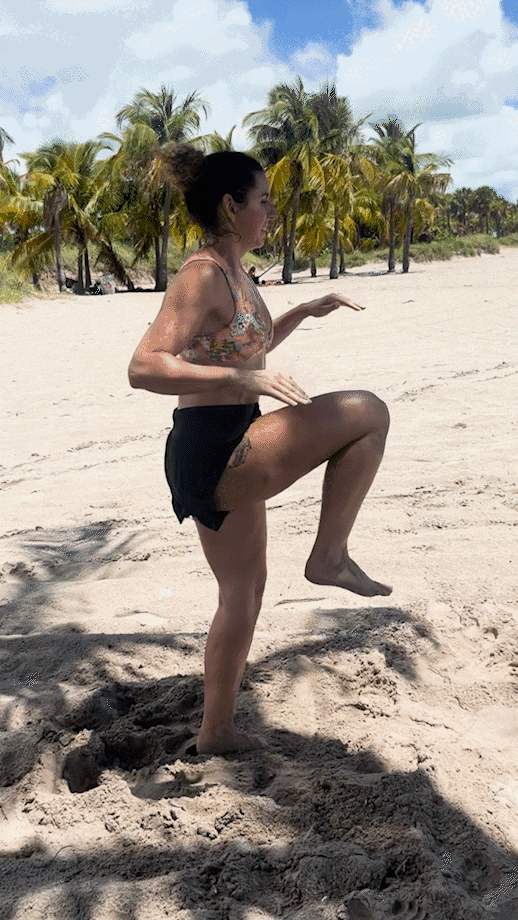
Up the Challenge: High Knees
For a more cardio-oriented exercise, try high knees. You’ll still get a lot of engagement out of the hamstrings and glutes, but in a different way—and it will really get your cardiovascular system buzzing. It’s already a tough exercise, and in the sand, it gets even harder due to the lack of energy feedback you get on a rubber gym floor.
How to do it:
- Start standing with your feet shoulder-width apart.
- Keep your gaze forward and your chest high. Bring your left knee up toward your chest, stopping just above waist level.
- Return your left leg to the ground and repeat with your right leg.
- You can perform this exercise slowly and make ground contact with your entire foot in between each rep, or you can do it quickly and bounce on the balls of your feet as if you are sprinting or jumping rope.
RELATED: 9 Strength-Building Hamstring Exercises to Do At Home
Move 4: Push-Ups
Why we love it: A strength training classic, push-ups are the ultimate bodyweight exercise for the upper body.
How to do it:
- Start in the high plank position or in the modified plank position on your knees. Either way, make sure your hands are stacked beneath your shoulders for stable joints.
- Bend your elbows and lower your chest toward the ground, taking care not to arch your back or let your hips sink.
- Press back up to the starting position, fully extending your elbows.
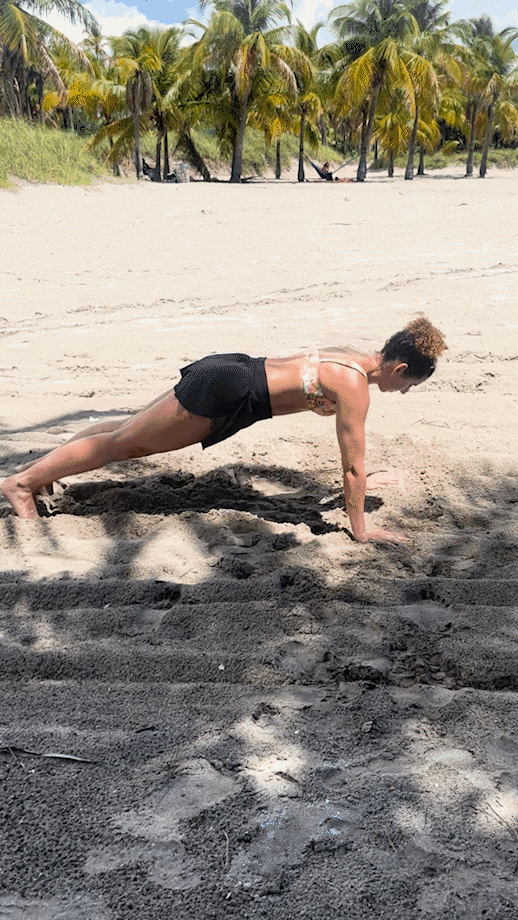
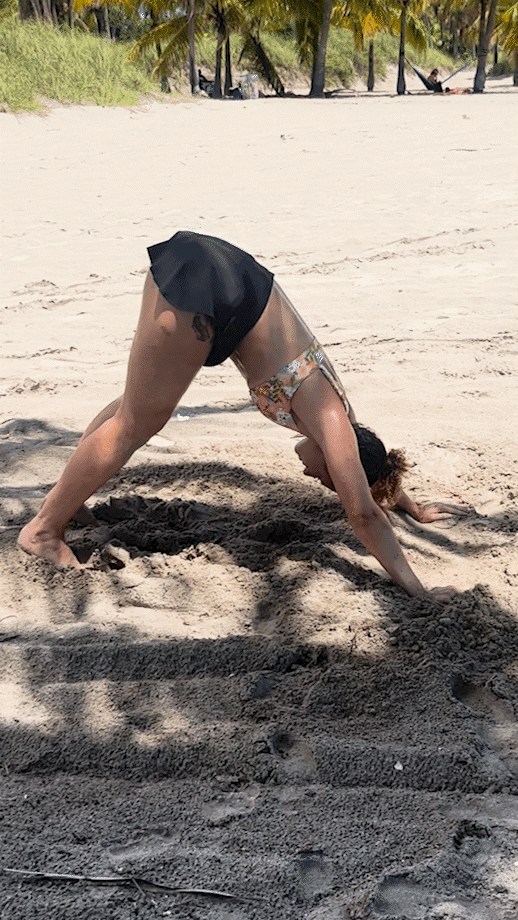
Up the Challenge: Pike Push-Up
A variation of the standard push-ups that engages the shoulders more than the chest muscles, pike push-ups are a fun swap or addition to a beach workout.
How to do it:
- Start in the high plank position. Walk your feet forward a few steps so that you are in the downward dog position with your hips raised high—envision your body as a triangle with the sand being the bottom.
- Bend your elbows and lower your head toward the ground. Careful not to flare your elbows: Keep your arms tucked to the body like you would during a standard push-up.
- Press back up into the downward dog position.
Move 5: Superman
Why we love it: The Superman exercise fires up the glutes and upper back muscles and is great for creating a mind-muscle connection with these two groups.
How to do it:
- Lie on your stomach on a beach towel or blanket.
- Engage your upper back muscles and lift your chest up from the ground, arms extended in front of your head.
- Engage your glutes and lift your legs up from the ground, aiming to have no contact between knees and the ground.
- Hold for 1 to 3 seconds and gently lower your arms and legs back to the ground.
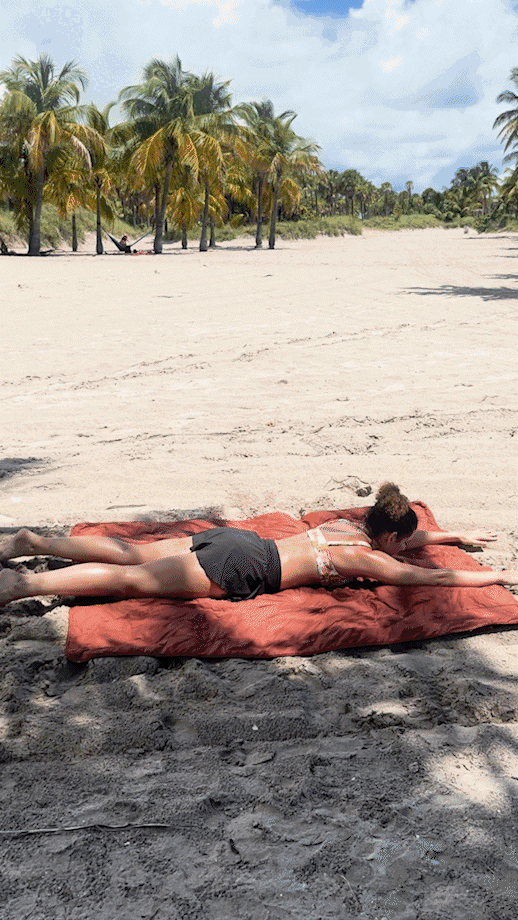
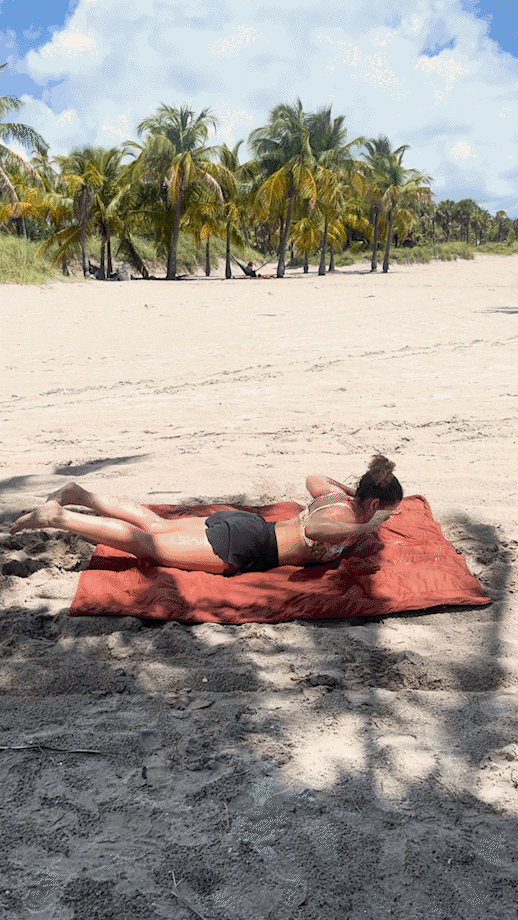
Up the Challenge: Superman with Shoulder Press
This move takes the Superman exercise to another level by adding in upper body movement.
How to do it:
- Lie on your stomach on a beach towel or blanket.
- Engage your upper back muscles and lift your chest up from the ground, arms extended in front of your head.
- Engage your glutes and lift your legs up from the ground, aiming to have no contact between knees and the ground.
- Bring your elbows to your sides, squeeze the lats, and then press your arms overhead as if you are doing a shoulder press.
- Return to the starting position.
RELATED: 17 Lower Back Exercises to Try For Stability and Strength
Move 6: Mountain Climbers
Why we love it: Mountain climbers isometrically challenge the upper body while dynamically challenging the core, specifically the oblique muscles.
How to do it:
- Start in the high plank position: Right hand and left hand both planted in the sand, stacked under the shoulders to position the arms in straight lines. Keep your spine in a neutral position (not arched or rounded).
- Draw your right knee to your left elbow. Return your right foot to the ground.
- Draw your left knee to your left elbow. Return your right foot to the ground.
- Repeat, alternating sides until you finish the set.
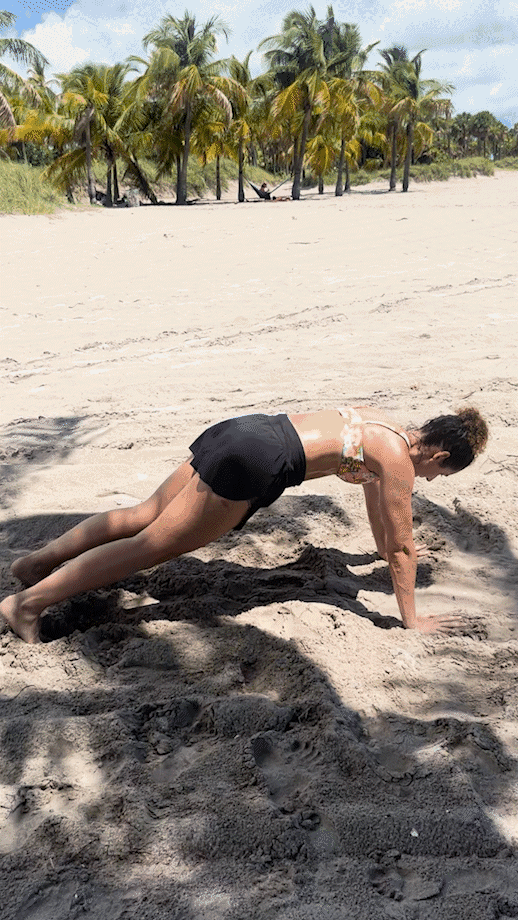
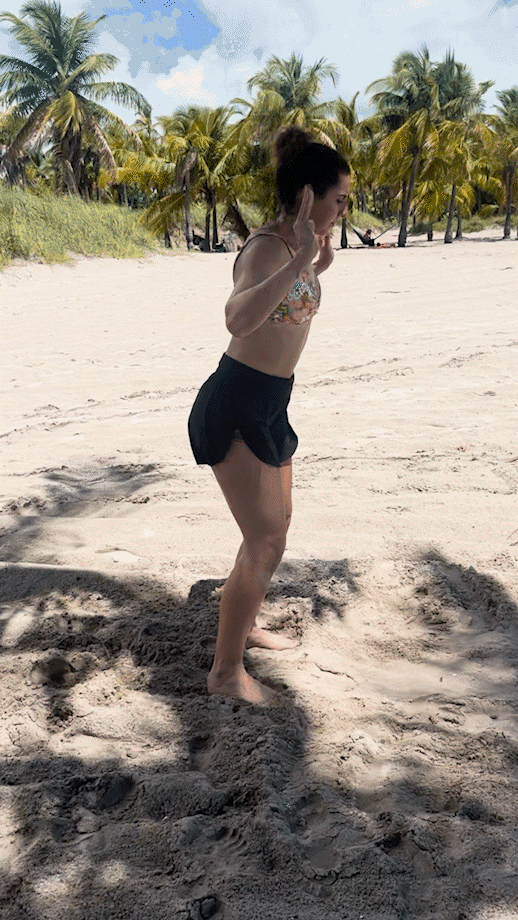
Up the Challenge: Half Burpees
Yeah, sorry, I’m including burpees! But they’re only half-burpees, so you won’t get all sandy from head to toe.
How to do it:
- Start in a standing position.
- Bend down and place both hands on the sand. Plant them firmly.
- Jump both feet back simultaneously, landing on the balls of your feet.
- Jump both feet forward, stand, and do a small vertical jump with your hands up.
Putting It All Together: Create Your Beach Workout
Warm Up
To prepare for the workout, you can do some easy cardio, such as a 5-minute light jog. You can also implement some bodyweight movements like walking lunges or bear crawls to prepare the muscles. It’s important not to start your workout “cold.” Warm ups increase your core temperature, increase blood flow, and gradually elevate your heart rate.
The Workout
For the workout itself, you can choose any number of rep and set schemes. Here are two ideas.
AMRAP (As Many Rounds/Reps As Possible)
For this format, you’d perform a set number of reps—let’s say five—of each exercise for a predetermined amount of time.
Complete as many rounds as possible in 15 to 20 minutes:
- 5 air squats
- 5 reverse alternating lunges
- 5 RDL to high knee
- 5 push-ups
- 5 supermans
- 5 (each side) mountain climbers
- 5 (each side) high knees
The key to a successful AMRAP is pacing yourself from the start: Don’t go out the gate too fast.
RELATED: 4 AMRAP Workouts to Add to Your Routine
HIIT Workout (High intensity Interval Training)
This format involves high-effort intervals followed by rest periods for an effective full-body workout in a short amount of time.
For each exercise, perform a 30-second near-maximal effort followed by 30 seconds of complete rest. Perform the exercises in the following order to allow for more rest time between lower and upper body.
- Air squats
- Push-ups
- RDL to high knee
- Superman
- Reverse alternating lunges
- Mountain climbers
- High knees
Cool Down
Finish up by stretching out your quads, hamstrings, shoulders, triceps, and calves. Going for a short 5-minute walk allows your body some time to return to its resting state.
Beach Workout: Final Thoughts
When you find yourself out of your usual workout routine on vacation, a beach workout is a great way to get some sun and some movement in without stressing about equipment or gym access. The exercises provided in this guide allow you to get a quick, effective full-body workout without taking up too much of your relaxation time.
Beach Workout FAQs
Should you do a beach workout on wet sand or dry sand?
The looser the sand, the tougher the workout will be. If you’re used to working out on hard surfaces like a gym floor, it’s safest to start on packed, wet sand. As you become more comfortable, you can move to dryer, looser sand.
Are beach workouts harder?
There is some evidence that beach workouts or sand workouts are more difficult than workouts performed on other types of ground. For instance, research published in the Journal of Experimental Biology1 found that running in sand requires 1.6 times more energy than running on a hard surface due to the increase in force production. Sand absorbs force rather than returning it to us: That’s why it’s so hard to jump high in sand compared to, say, on a basketball court.
What are the benefits of beach workouts?
Working out in the sand is a great way to challenge your balance, stability, and coordination. It may also burn more calories than doing the same workout on a gym floor due to the required increase in force production.
References
- Lejeune, TM, Willems, PA, Heglund, NC. Mechanics and energetics of human locomotion on sand. J Exp Biol. 1998; 201(13): 2071–2080. doi:10.1242/jeb.201.13.2071


